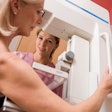Imaging societies and policy experts are watching as the Improving Seniors’ Timely Access to Care Act of 2025, which aims to streamline prior authorization processes, makes its rounds in Congress.
The bill was reintroduced on May 21 by Senators Roger Marshall, MD (R-KS), and Mark Warner (D-VA) and Representatives Mike Kelly (R-PA), Suzan DelBene (D-WA), Ami Bera, MD (D-CA), and John Joyce, MD (R-PA). Forty-seven Senate and 73 House members are co-sponsoring the bill, which would reform prior authorization processes under the Medicare Advantage program.
“[The bill] really wants to streamline that process to allow patients to get care in a timely fashion,” Catheryn Yashar, MD, health policy council chair for the American Society of Radiation Oncology (ASTRO), told AuntMinnie.
Radiologists have and continue to criticize current prior authorization processes for causing delays in treatment for patients. Current processes require radiologists and radiation oncologists to obtain prior authorization from third-party entities before ordering imaging tests or starting cancer therapy.
“It’s a burden for medical providers, and it’s really a burden for patients,” Yashar said. “Can you imagine having a delay to your medically appropriate care? We don’t even know sometimes why they’re denying, and that’s not quite right.”
In December 2024, ASTRO published the following results from its nationwide physician survey:
- Nine in 10 physicians reported treatment delays due to prior authorization. The reported delays affected about one-third of patients.
- About seven in 10 doctors say their patients face delays of a week or longer.
- One-third of survey respondents said that prior authorization has caused adverse events such as emergency room visits or hospitalization.
Yashar added that compared to ASTRO’s 2020 physician survey, where 52% of respondents said that delays for patients were more than five days, the 2024 survey showed that this had increased to 68%.
Catheryn Yashar, MD, from ASTRO shares results from a December 2024 national physician survey outlining how current prior authorization practices lead to vital treatment delays in radiation oncology.
Among the action points of the bill are shortening approval timelines, publishing data-driven guidelines as the basis for denial, and adding more oversight to increase accountability.
Sandy Coffta, vice president of client services at Healthcare Administrative Partners, said that about 97% of radiation oncology and 90% of radiology procedures require prior authorization. These two fields have, respectively, the highest and third-highest volumes of prior authorization, she added.
Coffta said this is due to complex and high-dollar treatment procedures and imaging tests, such as CT, MRI, and PET scans.
“To me, the biggest benefit is to patients,” she said of the bill. “The faster you get your imaging, the faster you get your diagnosis, the faster you get your treatment, and the better your outcomes are. So, it’s really a win all around.”
Sandy Coffta from Healthcare Administrative Partners explains the action points of the Improving Seniors’ Timely Access to Care Act toward reforming prior authorization practices.
In a statement to AuntMinnie, the American College of Radiology (ACR) reiterated its support for the Improving Seniors’ Timely Access to Care Act, noting that it is urging Congress to pass the Radiology Outpatient Ordering Transmission (ROOT) Act to implement Protecting Access to Medicare Act (PAMA) requirements that providers consult physician-developed appropriate use criteria when ordering advanced diagnostic imaging for Medicare beneficiaries.
“[Criteria]-based clinical decision support systems enable providers to access appropriate use criteria and order exams in real time – at the point of care – and do not interfere in doctor-patient decision-making,” the ACR said. “Appropriate use criteria promote value-based care, help Americans avoid unwarranted imaging and radiation exposure, and according to the 2023 Medicare Physician Fee Schedule Final Rule, reduce Medicare spending on low-value imaging by more than $700 million annually.”




















